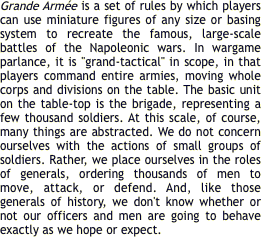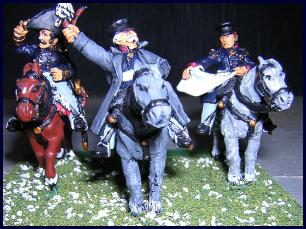|
|
|||||||||||||||||
 |
|||||||||||||||||
 |
|
[Introduction] [Reviews] [Scenarios] [Support] [Purchase] [Fast Play] [The Author] |
|
You can also check out the entry at the New Rules Directory
|
|
|
What is the ideal number of players? What are the key features and mechanics? No written orders? How does that work? How complex is the game? Can I finish in 4-5 hours? I’ve heard that Grande Armee is very abstract and generic. Is that true? Grande Armee has no figure or time scales. It has only a nominal ground scale of 1" = 100 yards. Each brigade has a number of Strength Points (SPs). This is calculated by taking the historical number of men in that unit and dividing it by a divsor based on its morale value. A unit of 3,000 militia might have only 5 SPs, whereas a unit of 3,000 Guards might have 10 SPs. Thus SPs represent both numbers and morale, because one is divided into the other. The SPs wax and wane with losses and recovery, representing the attrition of battle. A game day is divided into turns, but no two turns are the same. The day has a "Basic Length" based on the starting time and the weather conditions. Once this basic length has been reached, it is increasingly likely that each turn will be the last, until the day has finally ended. Players can estimate how much time they have remaining, but they can never be certain. Furthermore, each turn is divided into "Pulses," and one never knows how many there will be in a turn. There may be as few as one, or as many as six, and this is not known until a die roll at the end of a pulse indicates that that pulse had been the last one for that turn. All of this makes for a very tense and unpredictable situation: You may be expecting reinforcements on Turn 2, but who knows how long Turn 1 will last. You may think you've set up a grand battery with a deadly killing zone, only to find that the enemy has seized the initiative and charged his light cavalry into it before you could open fire. You may have kept your elites in reserve for the big game-winning charge, only to find that the sun set earlier than you expected, ending the battle as your enemy slips away. Grande Armee uses a 3" square base for infantry and cavalry units, to represent a "brigade area" of operations. It doesn't matter what size figures you own, or what basing system you have. You can just make 3" square movement trays, and put your figures on them. If you ever decide you'd like to play something besides Grande Armee (unlikely as that may sound) just put your movement trays aside and your figures are back to their old basings. All the unit information is contained on your roster, to keep it out of sight of the enemy. So there is no "figure scale" in the traditional sense at all. What matters is the size of the bases. A survey of over 100 Grande Armee players found that the most popular scale for the game is 6mm, which make fabulous dioramas, because you can have four or more "battalions" deployed on the bases, with a skirmish line up front. (Nonetheless I remain faithful to my big 28mm figures.)
|
|
-2The 15mm Spanish grenadiers in the middle are mounted to another popular game system, and have just been put on a 3" base. The 6mm figures on the right are from my own collection. You can really "see" the brigade deployed in a checkerboard formation with skirmishers up front. Meanwhile on the left, the 28mm figures give a nice, detailed presentation.Artillery units are mounted on rectangular bases 1.5" wide by 3" deep. |
|
For newer players I always recommend one corps per player. (That's usually 8-20 units per player.) More experienced players can handle multiple corps without slowing the game down. The Grande Armee book contains an introductory scenario (Fuentes de Onooro) that is ideal for two new players. This web site also has several small scenarios available for you to download. Grande Armee is uniquely different from most Napoleonic games in several ways. Two of these (flexible basing and no time/figure scales) have already been mentioned above. Some others include: Variable Movement: You only know roughly how fast your units will move each turn. It's variable, based on your level of control of those units, the presence of the enemy, the weather, and the terrain. (Terrain penalties for movement are also unpredictable.) And once your units get in close with the enemy, they may or may not attack, in spite of your wishes. Does this sound complicated? It isn't; one six-sided die roll takes care of it all, for each unit. No Written Orders: Using the Command Point (CP) chits, each player makes decisions about the control of his forces. Those which aren't controlled may or may not behave as he wishes. Weather is extremely important, not an optional add-on at the end. Visibility is central to the game's command and control system, and ground condition affects everything. Chaos: You're the army commander. So you can't control things like skirmishing, opportunity charges, evasions, and so on. All these things happen on their own, often in ways you didn't want or expect. If you expend your precious CP chits to micro-manage one portion of your army, control slips in the other parts. You can only do so much at once, and for the rest you hope for the best. Army Morale and Pursuit: You have to conserve your cavalry for a pursuit (if you're victorious) or to cover your retreat. Unlike most games, where there's "no tomorrow," Grande Armee has a seamless procedure for campaigns and multi-day battles, so that one battle flows into another, and you have to make historical decisions about whether or not to risk committing your reserves. You might win the battle, but the enemy gets away because of his cavalry screen, or darkness, or bad weather, or.... At the beginning of each turn, the army commander gets a number of Command Points (CPs) based on his skill, the weather, the type of army, and a die roll. The CPs are used for a number of things in the game, such as creating detachments, assisting rally attempts for broken units, altering the initiative rolls, and so on. But their most important function is to give the army commander some control over his corps commanders. Each corps commander has a Control Number which expresses his "cost" in CPs. An excellent general has a low control number, meaning that he requires little maintenance or attention. A difficult commander requires more CPs to control him. The further away a general is, the more the CP cost goes up. Generals who do not receive CPs are "acting on their own," sometimes as you wish, sometimes not. Some generals are Aggressive, some Cautious, and this will also play a role in determining how their corps behaves in this pulse. Generals whose forces are engaged with the enemy are less predictable and harder to control. Finally, the army commander never knows how long the turn will last, so he has to make difficult decisions about how and when to spend his CPs. If there is a long turn, he will certainly run out of CPs, rendering his control of his subordinates more difficult. If he hoards his CPs and the turn ends early, he will have squandered his opportunities for action. Complexity is relative; some of this depends on you. But I think Grande Armee could be described as "intermediate" in complexity. The rules-portion of the rule book is about 40 pages. All charts and tables fit on one double-sided sheet. I have taught the game to complete novices at many conventions. The tutorial usually takes half an hour, and most people have mastered the game by Turn 2. Playing time depends again on the players; everybody plays at a different pace. The average game seems to run about four hours. I don't know about you, but that's usually all I'm good for these days! If by "generic" you mean a set of rules that could apply to anything in the horse-and-musket era, then No. Grande Armee is specifically designed for the Napoleonic period, with rules and values that wouldn't apply to anything else. It is not a multi-period game and doesn't share much in common with existing multi-period games. As for "abstract," it depends on what you want. All games choose a level of abstraction, and different players have different preferences for where that level of abstraction falls. If you are the kind of player who wants to play out every step of a cavalry charge: checking morale, moving to contact, checking to see if the defending square held, resolving defensive fire, checking to see if the cavalry broke through or rode around, resolving casualties, checking fatigue, etc., etc.... then this is not the game for you. All of these things are considered in the resolution model, but they are not represented by separate activities. Grande Armee places you at the corps or army-command level, where you do not exercise that degree of micro-management. Think of yourself as an army commander, squinting through his telescope to see the cavalry, and wondering simply: "Did our boys break them?" |
|
[Home] [15mm World] [Reviews Home] [How To] [Beginners Guide] [Gamer's World] [Spanner & The Yank] [Points of View] [The Annex] [Links] [Say Howdy] [Corporate Schill] [Rules Directory] |
 |
|||
|
|
|||


